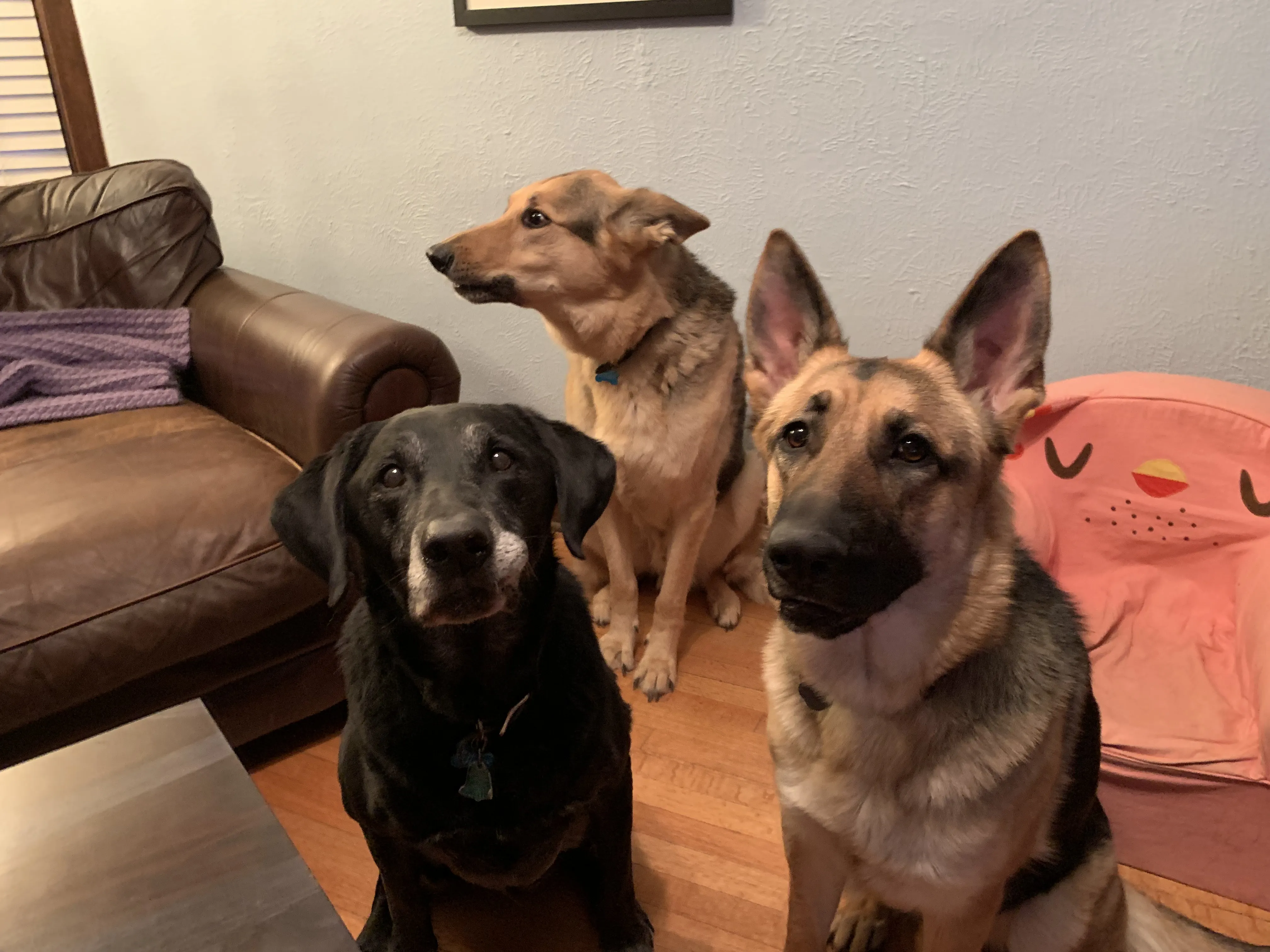Is your dog reluctant to come inside when called, transforming a simple request into a frustrating standoff? This common behavioral challenge can be both inconvenient and, at times, a safety concern. Mastering the “come inside” command is not only crucial for routine management but also strengthens the bond and trust between you and your canine companion. This comprehensive guide will explore effective methods on How To Train A Dog To Come Inside, turning this challenge into a rewarding success, drawing insights from real-world experiences like Evy, a German Shepherd who struggled with this very issue. Establishing clear boundaries and consistent training can also help prevent your puppy from jumping on guests in your home, setting a foundation for overall good manners.
 German Shepherd Evy with her housemates, a Black Lab and another German Shepherd, relaxing outdoors.
German Shepherd Evy with her housemates, a Black Lab and another German Shepherd, relaxing outdoors.
Why Your Dog Might Resist Coming Inside
Understanding the root cause of your dog’s reluctance is the first step toward a solution. Several factors can contribute to a dog’s refusal to come indoors:
- Lack of Training or Understanding: Often, dogs simply haven’t been adequately taught what “come inside” means. They might not connect the verbal cue with the desired action, as was the case with Evy.
- Negative Associations: If coming inside has previously been linked with negative experiences, such as scolding, punishment, or the end of a fun outdoor play session, dogs may become hesitant. It’s vital to create a positive environment.
- Outdoor Stimulation vs. Indoor Boredom: The outdoor world offers a myriad of exciting sights, sounds, and smells. If the indoor environment is less stimulating, your dog might naturally prefer to stay outside, especially if they are accustomed to making their own choices about when to come in. Similarly, a dog might be more prone to other behavioral challenges if their environment isn’t properly managed, such as when you teach your puppy not to jump on furniture in the home.
- Breed Predisposition & Independence: Some dog breeds are naturally more independent or have a stronger drive to explore, making them less inclined to readily follow commands, particularly if they are engrossed in an activity.
- Anxiety or Fear: In some cases, anxiety or specific fears, like a fear of the dark, can make a dog reluctant to enter the house.
Effective Strategies to Teach Your Dog to Come Inside
Training a dog to reliably come inside requires patience, consistency, and the right approach. Here’s how to turn this behavior around:
Stop Repeating Commands
One of the most common mistakes owners make is repeatedly calling their dog when it doesn’t respond. This inadvertently teaches the dog to ignore the command. If you call “Come!” five times before your dog finally saunters in, you’ve taught them that they only need to respond on the fifth call. Instead, give the command once, wait, and if there’s no response, try a different tactic or simply go retrieve them without further verbal commands.
Embrace Passive Training and Positive Reinforcement
This method focuses on rewarding the desired behavior when it occurs naturally, rather than forcing it. When your dog is outside and you want them to come in, don’t call them. Instead, open the door and wait. The moment your dog shows any inclination to come inside, or actually steps over the threshold, immediately reward them with a high-value treat and enthusiastic praise. This passive approach allows the dog to “discover” that coming inside leads to a positive outcome, forming a new habit quickly. This foundational approach of setting clear expectations is also vital when learning to manage your dog’s jumping on people as part of their general manners.
Establish a Leader-Follower Dynamic
A healthy leader-follower dynamic is crucial for overall obedience. By consistently enforcing rules and providing structure, your dog learns to see you as the reliable leader, making them more inclined to follow your commands. This includes:
- Petting with a Purpose: Don’t just give attention on demand. Ask for a simple action (like “sit”) before petting. This teaches your dog that desired behaviors earn rewards.
- Consistent Rules: Establish clear boundaries, especially around resources like food or toys, to prevent your dog from challenging other pets or family members.
- Rewarding Wanted Behaviors: Actively look for opportunities to reward your dog when they exhibit behaviors you like, even if you didn’t explicitly ask for them. This positive reinforcement reinforces good choices. Just as you’d work to teach patience and self-control for the ‘come inside’ command, similar principles apply when addressing dogs jumping on the couch or other furniture.
By becoming a consistent and benevolent leader, your dog will be more motivated to listen and obey, not out of fear, but out of respect and the desire for positive interaction.
Conclusion
Teaching your dog to reliably come inside doesn’t have to be a battle. By understanding the reasons behind their reluctance and implementing positive, consistent training methods, you can transform this challenging behavior. Remember to avoid repeating commands, leverage passive training with high-value rewards, and foster a clear leader-follower dynamic through consistent rules and purposeful interactions. With patience and dedication, you’ll soon enjoy a harmonious routine with a happy, well-behaved companion who eagerly responds to your call. Mastering these core commands builds a foundation of respect and understanding, much like when you seek to curb excessive barking at other dogs in social settings. Start implementing these strategies today and witness the positive change in your dog’s behavior!
